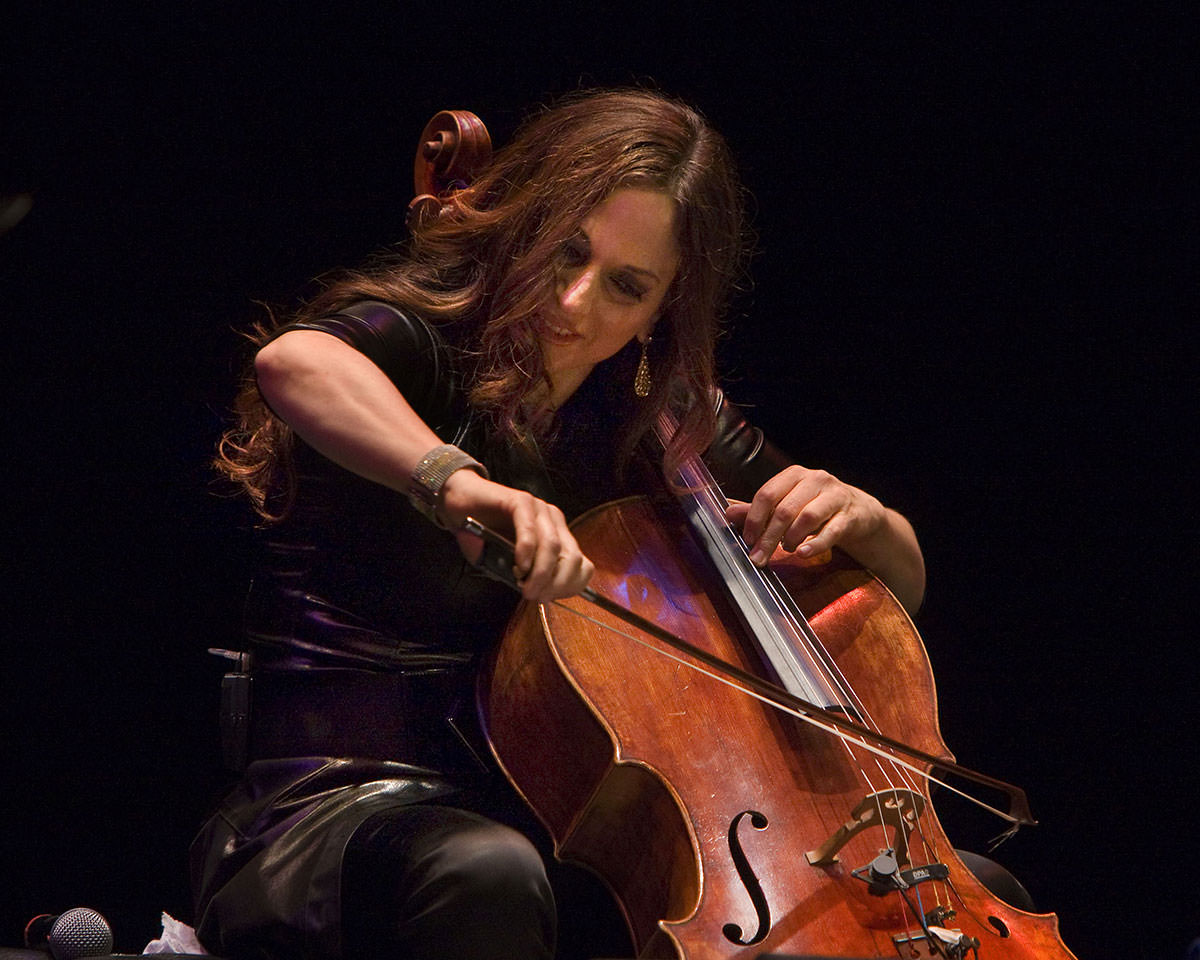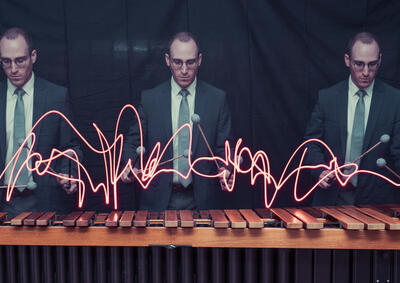Cellist Maya Beiser: Creating Music, the Mantra to Move People
It might seem unlikely that someone raised on a strict religious kibbutz in the Galilee Mountains, who trained as a classical cellist and graduated from Yale, would become an innovator, a collaborative artist who commissions and stars in unusual and never-before-seen combinations of sounds, visuals, and text — but cellist Maya Beiser is exactly such an explorer. Her upcoming show at Bing Concert Hall at Stanford University this weekend — which includes the work of the digital artists known as the OpenEndedGroup, along with Ko Ishikawa, renown player of the shō, an ancient Chinese and later Japanese reed instrument, plus the work of composer Jaroslaw Kapuscinski — is typical of her work in that it employs diverse elements, but unusual in that Beiser was invited to participate by Kapuscinski, rather than instigating the project herself. But, true to form, Beiser is learning from her collaborators and making the most of the creative process as she prepares to bring the public something that is new and, she hopes, relevant to their lives.
Beiser set out on her trailblazing path early after her college years when she was the founding cellist with the new-music ensemble Bang on a Can All-Stars, in New York City. That path, which has included collaborations with well-known artists such as Brian Eno, Steve Reich, Philip Glass, and film composer James Newton Howard, has been full of acclaim, including top-selling albums on the classical and world-music charts, performances at many of the globe’s greatest concert halls and festivals, and an ever-evolving series of performances such as her cello opera, Elsewhere, and next year’s performance of All Vows at the Yerba Buena Center for the Arts in San Francisco.
What would you say was the key turning point for you as an artist, when you realized that you wanted to do something more than play Bach’s Suites or be in a traditional string quartet?
Well, I think there was more than one moment. It was more the overall trajectory of my life that brought me to that. The moment I think where everything crystallized for me was the moment that I graduated from Yale. That was that moment you look in the mirror and you say, “OK, now life begins, and why am I doing this?” We each have our path that life takes us on, and music became my passion at a very early age, for many different reasons. But I think probably the strongest one was that it was just this gift that I found. I grew up on a kibbutz in the northern part of Israel and it was a pretty scary time and I wasn’t particularly happy there, for all kinds of reasons, although it was a very special community. But I was a very individual-minded kind of person and it was a commune and you had to kind of follow everybody else’s rules, which was very hard for me. So when I first played the cello and I found this world, it was this incredible thing. But of course as a child you don’t really get to make decisions in the same way and I was classically trained and I was playing all the classical repertoire during my childhood.
But throughout it all, for me, there was always this sense that I wanted to do something that nobody else did, and I think that was a lot of it. I felt like I needed to make something new. And I guess when I was at Yale and after graduation I just realized that what I wanted was to be a part of the creative process. I didn’t just want to be quote, unquote, an interpreter and I do say “quote/unquote” because being an interpreter is a fantastic and beautiful thing. But for me, I wanted to take the cello on a new path. I wanted to connect with other kinds of music. I wanted to make a statement as an artist. So that was really the beginning.
What do you think is the root of your interest in the visual arts? Or do you think modern audiences are simply more visual because of their constant exposure to video? Why do you think that element is included in so much of your work?
Well, I actually think both. I’m a visual person. Aesthetics and visual art has always been a very strong part of my interest. And I’ve always imagined music; whether it’s new music or as a child playing the classical repertoire, I always created a story in my mind and I always saw visuals, except that back then I didn’t think I could make those visuals come alive except through the music. And there’s something wonderful about that, because when you just play the music, each person can make up their own visual story, and I think we do. But I think that for me what I want to do is bring my audience to my own narrative and present something that is more encompassing. And in that context, I do think that we live in a world that is visual. Everything is visual these days, and I also think that we respond to visuals in a very powerful way and I think we connect to music in a very powerful way, and I think it’s very natural. So the idea to create visuals that either express elements in the music or that have their own life, or just create a world that includes visuals, is just very natural and always a part of how I saw it.
You know, I started very small. My debut concert in New York after graduating from Yale — I think it was 1992 at the 92nd Street Y — was a concert with some contemporary music, and the first piece I commissioned, it was from David Lang, but also had some more-mainstream repertoire. But in that concert I just thought maybe we’ll just change the lighting a little bit, because it just felt unnatural to me to have this one harsh light through the whole thing, the standard concert light that we always had; and to be honest it was just my reaction. I just came off stage and said, “Do you guys have a lighting designer? Is there something we can do? I’m starting with this Lutoslawski piece and I just want to start in the dark.” And we did that, and at the time it was completely unheard of to even have a lighting designer in a “straight” concert hall. I think to this day a lot of places don’t. If I’m coming to play, then they would, because I ask for it.
I think the issue is that in the classical music world we’ve been stuck in these rules about how things “have to be.” Because the trajectory of my life has always been not to accept rules and to question them, probably because of the way I grew up in this very restrictive society and because my personality is really about questioning everything and trying to find other ways, those rules just never really felt right to me. So I wanted to create my own rules and the rules about how to create music in a live performance. And what’s still driving me today is “what does the music tell me?” or “what does the idea tell me?” And I go from there to decide what it will be, who my collaborators will be. And sometimes the music just really doesn’t need anything, or sometimes the music is just about being there completely naked, and that’s fine, too.






